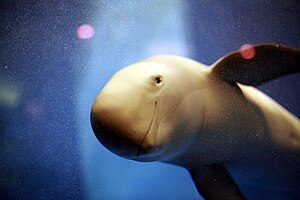Eastern porpoise whale
| Eastern porpoise whale | ||||||||||||
|---|---|---|---|---|---|---|---|---|---|---|---|---|

An eastern porpoise in the Miyajima aquarium . |
||||||||||||
| Systematics | ||||||||||||
|
||||||||||||
| Scientific name | ||||||||||||
| Neophocaena asiaeorientalis | ||||||||||||
| ( Pilleri & Gihr , 1972) |
The eastern porpoise ( Neophocaena asiaeorientalis ) is an East Asian whale species from the porpoise family (Phocoenidae). The species was described in 1972 , but the two subspecies of the species were later assigned to the porpoise ( Neophocaena phocaenoides ). After it was discovered that the animals are reproductively isolated from one another, even though they occur together in a relatively large area, the species was revalidated and re-described in 2011.
description
With a length of over 2.20 meters, the eastern porpoise is significantly larger than the porpoise, which only reaches a maximum length of 1.70 meters. The head is small and clearly rounded by the melon . The skull length is 21 to 29.5 cm (18 to 24.5 in N. phocaenoides ). The snout is broad, short and between 7.7 and 9.7 cm long (6.2 to 9.2 in N. phocaenoides ). There are 16 to 21 teeth per half of the jaw in the upper jaw and 15 to 20 in the lower jaw (15 to 22 or 16 to 22 for N. phocaenoides ). Both porpoise species lack the fin , which is why they are also called finless porpoises. For this they have a fleshy ridge on their back, which is provided with rows of tubercles. The ridge begins in the eastern right porpoise in front of the middle of the back, is relatively high and can reach a maximum height of 5.5 cm. The tubercles stand in one to ten rows, the backbone covered with tubercles is narrow and only 2 to 12, in exceptional cases 24 mm wide. In N. phocaenoides the spine begins behind the middle of the back, is lower but wider (4.8 to 12 cm) and the number of tubercle rows is 10 to 17, in exceptional cases it can be only nine or up to 25 rows.
Adult eastern porpoises are light cream to dark gray, mostly medium gray in color. Young animals are dark gray and get lighter with age. N. phocaenoides , on the other hand, is dark gray, often almost black and has light gray young animals.
Subspecies
There are two subspecies:
- The Yangtze River porpoise ( N. asiaeorientalis asiaeorientalis , (Pilleri & Gihr, 1972)), which occurs in the catchment area of the middle and lower Yangtze River and is very rare. The subspecies lives only in freshwater, including Lake Poyang and the Gan Jiang River , which flows through the lake, and Dongting Lake with its largest tributary, the Xiang Jiang . In the Yangtze River, the dolphin occurs (or came) up to about 1600 km up the estuary, about as far as the city of Yichang .
- The East Asian porpoise ( N. asiaeorientalis sunameri , Pilleri & Gihr, 1975) lives near the coast in the sea, in the Formosa Strait , in the Yellow Sea , on the east coast of South Korea and on the coasts of southern Japan. The Korean and Japanese populations have no contact with each other.
literature
- Jefferson, TA and JY Wang, 2011: Revision of the taxonomy of finless porpoises (genus Neophocaena): the existence of two species . Journal of Marine Animals and Their Ecology 4: pp. 3-16.
Web links
- Neophocaena asiaeorientalis in the endangered Red List species the IUCN 2012. Posted by: Wang, JY & Reeves, R., 2011. Accessed January 30, 2015.